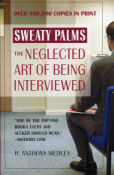| What REALLY goes on in a job interview? Find out in the new revision of "Sweaty Palms: The Neglected Art of Being Interviewed" (Warner Books) by Tony Medley, updated for the world of the Internet . Over 500,000 copies in print and the only book on the job interview written by an experienced interviewer, one who has conducted thousands of interviews. This is the truth, not the ivory tower speculations of those who write but have no actual experience. "One of the top five books every job seeker should read," says Hotjobs.com. | |
|
The Sound of Music at the Hollywood Bowl by Tony Medley I’ve seen “The Sound of Music” so many times, both on the stage and the movie, that I could probably be cast in any role and know the lines. But most people know it through the movie, and the movie and the play have distinct differences, one of which is different music. After Oscar Hammerstein died and the movie deal was made, Richard Rogers dumped two songs from the play and wrote new ones, and it wasn’t a good idea. Dropped, both from the second act, was “No Way to Stop It,” a charming song sung by Captain von Trapp (John Schneider, whose strong voice is a welcome departure from prior Captains like Theodore Bikel on Broadway and the movie’s Christopher Plummer, whose singing voice had to be dubbed by Bill Lee), Max Detweiler(Jeffrey Tambor, who seemed lost in the part) and Baroness Elsa Shraeder (Rachel York, who is as delightfully acquisitive as was Eleanor Parker in the film) as Max is trying to convince the Captain that he doesn’t have to bow his head, just “stoop a little” to the Nazis, Every star and every whirling planet, and every constellation in the sky, revolves around the center of the universe, that lovely thing called I! I! I! I! Nothing else as wonderful As I, I, I, I, I! You won’t hear this in the movie, so it’s a delight to hear it again on stage. Another song Rogers replaced was the love song, “An Ordinary Couple,” a duet between Maria (Melissa Errico) and the Captain after they declare their love for one another. Rogers never liked it, so when he had the opportunity, he jettisoned it for a new song, “Something Good.” My feeling has always been that “Something Good,” while tuneful, is too pedestrian and self-centered, talking about Maria having done something good to deserve the Captain. “An Ordinary Couple,” with its delightfully sophisticated antipodal approach (they are certainly not an “ordinary” couple) and better melody, seemed much more romantic to me: An ordinary couple Is all we’ll ever be. But all I want of living Is to keep you close to me. These decisions show why Rogers never remotely approached the same lofty heights after he lost his lyricist and emphasize the value of words to a song. The movie also moved songs. In the play, “The Lonely Goatherd,” is a yodeling song that Maria sings to the children in her bedroom in the first act. In the movie it was moved to the second act in order to introduce Bil and Cora Baird’s puppets. The Hollywood Bowl production is a showcase for the talents of the wonderful Melissa Errico, who charmed Bowl audiences last year as Guinevere in “Camelot.” She is equally compelling as Maria. She is beautiful; her acting is accomplished, but it’s her voice! It is breathtakingly clear and lush. Andrea Bowen plays the eldest daughter, Leisl, to great effect. There isn’t much dancing in “The Sound of Music,” but she does two of them and does them very well. I was sitting up close and watching her feet, however. The Bowl is so huge that if you aren’t up that close, her dancing might not have much impact. The best part of the movie for me has always been “Laendler,” the Austrian folk dance during which Maria and the Captain fall in love. Director Robert Wise, Julie Andrews, and Christopher Plummer played this to such wonderful effect that it is still the highlight of the film for me. Unfortunately, there isn’t the same magical chemistry between Schneider and Errico when they do the dance that was achieved in the movie. But these are just trifles. “The Sound of Music” is about the best of American music and it’s a rare pleasure to sit under the stars and enjoy it with such a brilliant production. July 30, 2006 |
|
|
|
|
